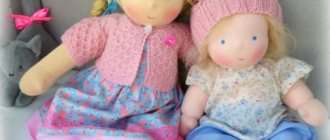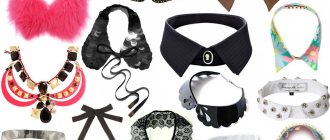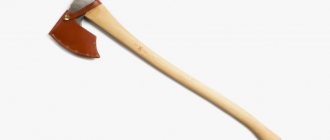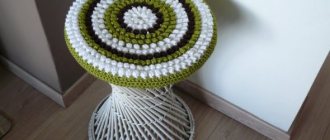To complete a woman's costume, a headdress - a beret or cap - is often missing. And sometimes, the beret becomes the main decoration of the entire costume ensemble. Buying a ready-made beret is quite difficult, since it is difficult to match the required model, color, tone, shape, etc. Therefore, you can try to sew a beret with your own hands, especially since the beret pattern is not at all complicated, and the technology for sewing a soft-shaped beret does not require a special sewing machine.
I offer you two beret patterns. The first one is somewhat similar in shape to a male airborne military beret, or an artist’s beret. This is a fairly universal pattern, making small adjustments will allow you to sew various women's, children's and even men's berets. The second beret pattern is more likely intended for sewing a cap with a visor, but such a cap made of soft fabrics and without too hard padding in the visor can also be called a beret.
For sewing a beret with your own hands, soft-shaped berets are the most accessible. They are easy to make, do not require special sewing equipment, are comfortable to wear and complement a modern women's suit well. To sew a soft-shaped beret, you can use a wide variety of materials: leather, suede, drape fabrics, including fur skins. Before sewing a beret, you must check (clarify) the pattern. First, cut out the details of the beret from inexpensive thick fabric. When trying on, make the required adjustments to the pattern and, if necessary, change the cut of the “trial” sample. And only after this can you transfer the exact pattern of the beret parts onto the prepared fabric, fur or other material and begin sewing.
How to take head measurements to create a beret pattern
Before sewing a beret or cap, you need to accurately measure your head. To determine the size of any headdress, it is necessary to place a measuring tape around the widest part of the head, as shown in the figure - through the frontal tuberosity and the protrusion of the occipital bone. The length of the head circumference line passing precisely in these parts will be the size of any headdress.
This head circumference measurement (Ogol) can also be used when purchasing a ready-made product. When taking measurements, do not tighten the tape too much, but do not loosen it either. If the measurements are taken inaccurately, this will be strongly felt when wearing a beret. The beret will either have to be constantly adjusted, since it will slip, or, on the contrary, it will have to be pulled tight. Do not forget also about the thickness of the lining and the sealing of the edging seam; this is especially important to consider when sewing a beret with a visor.
The proposed pattern for a soft-shaped women's beret is just one of hundreds of options. The advantage of this particular pattern is that it is quite simple to construct; moreover, this beret model takes on the “correct shape”, since instead of solid wedges an additional cut-out element (side) is used. Men's military berets are cut approximately according to this type. By changing the radius of the circumference of the bottom and side, you can change the size of the “blockage” and a woman’s beret can easily be turned into a man’s.
The top diagram shows a model of a size 57 beret, the round bottom of which can be either solid or cut out of four wedges. There is no need to describe in detail how to make a pattern for this beret; the diagram is quite simple. I’d rather pay more attention to the technology of sewing a beret.
Technology of sewing and cutting a beret. Firstly, when cutting, never forget to leave allowances, but this pattern already has 1cm allowances, so you just need to take into account the quality and density of your fabric. Typically, allowances should be at least 0.8 cm, but if the fabric is very loose and free-flowing, then you can leave 1.0-1.5 cm. Since the beret is lined, the details of diagrams 1 and 2 need to be duplicated in the lining fabric. It is advisable to make seam allowances for very “loose” linings no less than 1.5 cm. A cashpen (size strip) is a strip of fabric folded in half and stitched on an interfacing for greater rigidity and size retention. It is advisable to cut out this strip entirely, but if you do not have enough fabric or the design of the beret includes many decorative seams, then you can cut it out from 2, 4 or more parts. Keep in mind that numerous connecting seams can change the volume of the beret on the head, usually in the direction of reducing it, so be sure to try on a strip sewn into a circle.
The side can also consist of two or four parts. First you need to “assemble” it into a circle, delay the seams, not forgetting to compare the resulting volume of the lower part with the volume of the size strip. The upper volume must simultaneously coincide with the bottom. The wedges of the bottom of the beret are ground off, stitched with a finishing stitch, then the bottom is connected to the prepared side, and the side is connected to the cache-pin. The lining is cut out according to the details of the top, the lining parts are connected on a sewing machine, leaving an unstitched “window” in the seam connecting the bottom to the side - about 10 cm. The lining and the seam connecting the side to the cache-pin are fastened face to face and stitched. Through the “window” left, the beret is turned right side out and the hole is sealed manually or by machine. If you have experience working with fur, then such a beret can be sewn from fur; a beret will “lie” especially beautifully, sewn from skins with short fur, such as mink fur.
Sewing such a beret with your own hands will require some experience from you, and it is possible that you may not succeed the first time. Therefore, don’t get excited about making it from expensive fabric right away. First try to sew a prototype, “fit the pattern”, practice the techniques of connecting parts, a visor, a lining, and only after that you can cut the expensive fabric.
Perhaps not every woman likes a cap, but if you are reading this article, you probably need one. The raglan cap is a universal headdress. It is worn not only by women, but also by men, the elderly and children, girls and boys. It’s easy to sew such a beret with a visor with your own hands, even with a little experience. You can sew a beret with a visor from any fabric, but it is better to use soft coat or drape fabric, leather, leatherette, suede, etc.
Despite the many numbers on the pattern diagram, it is quite simple to construct the drawing, so again, I will not comment on the construction. I will only note that for convenience, the beret pattern is made together with seams with 1cm seams. Construct a drawing of a beret pattern according to the diagram, place the pattern details on the fabric or material, observing the direction of the cut (the thread is indicated by an arrow), trace, cut.
Beret sewing technology. Sew a dart in the bottom and stitch it out. After this, stitch and stitch the edge details. Then connect the bottom and the side, the center of the side with the center of the front. Stitch these parts together around the entire perimeter, stitch the edge to the bottom. Visor for a beret. Stitch two parts, turn them inside out, iron them, topstitch them, insert a liner made of hard cardboard or plastic so that 1.5 cm is left free at the open edge for the stitching seam with the cache-pin. The visor is inserted between two strips of fabric, and a strip of cushioning or adhesive materials is placed on top, for example, a pad made of proclamylene or even ordinary dense calico. They grind it down, turn it inside out, and stitch it to the edge.
The details of the top can also be padded, which then results in a more rigid shape of the cap. Prepare a lining, cut according to the details of the top. Connect all the pieces together by matching the center front of both the top and the lining. Sweep them, put a cache-pin with a visor between the top and the lining, face to face. Sew this seam, turn the beret right side out and seal the hole in the lining. The beret is ready.
In fact, sewing a beret in practice is not so quick and easy. It is especially difficult to accurately “maintain” the dimensions of the volume of a beret. 1. Try to connect all the parts on the machine without seating. Despite its small size, even a slight “landing” will distort the size of the entire beret. Rounded shapes “feel” such errors very strongly and as a result, the volume of your headdress may change or parts may become skewed. 2. Baste all the parts before sewing them on the machine, try them on more often. Pay special attention to the volume and size of the beret. 3. In order for the round seam to be laid out evenly, the allowances connected in a circle must be “cut out”, cut with corners without catching the connecting seam, at a distance of 1.0-1.5 cm from each other. The denser the fabric, the closer you can “come” to the seam, but not less than 3mm. 4. Never smooth the connecting seams along the front side. In extreme cases, the front side can be treated with hot steam, and then put on a mannequin or an empty glass jar so that the moistened fabric takes the required shape. 5. In order to iron rounded seams, you need to use a special iron or, in extreme cases, an attachment to the ironing board, carefully centimeter by centimeter, ironing them on the wrong side with the nose of the iron. 6. Instead of a cashpen (strip), you can use bias tape to trim the edge of the beret. This processing is much easier to lay out in a circle, the seam does not wrinkle, and most importantly, you can use ready-made factory bias tape. When stitching the trim, try not to pull it too much, otherwise the size of the beret may decrease and will be tight and uncomfortable. 7. The fabric consumption for sewing a beret is small, but, nevertheless, it is advisable to know in advance how much it will be necessary to buy. To do this, lay out the details of the beret pattern over the entire width of the fabric, taking into account the longitudinal direction of the thread. 8. If you have a beret that you really like, its pattern can be easily removed using simple techniques for copying the cut details. More accurate results can be achieved if you completely disassemble the beret and use the ironed parts as a pattern.
July 21, 2017
One of the distinguishing features of the various branches of the military is their uniform. It consists of many parts, but there is one that is the source of the greatest pride. Of course, we are talking about the headdress. For example, a paratrooper’s beret (photo below) not only covers his head from the wind and scorching sun, but is also his constant companion.
Buying a ready-made beret in our time is not considered a significant problem, but sewing this headdress yourself is considered especially chic. The pattern of a paratrooper's beret is not something particularly difficult. So if you have ever held a needle in your hands, sewing this product will not be difficult.
From the history of blue berets
This fashion reached the Soviet Union only in the 60s. Interestingly, the Marines were the first to wear this headdress. Berets appeared in the Airborne Forces in 1967. Few people know that the original berets were not blue, but crimson. Although the color blue was available in the landing uniform even then (edgings and shoulder straps). The crimson color of the berets was proposed by the artist Zhuk, who borrowed this color from paratroopers of other countries.
The crimson color was not the only one. The artist demonstrated two versions of color schemes to General Margelov. In addition to crimson, there was also a protective color. Berets of this color were planned to be worn as everyday wear, although this remained just a project. Raspberry berets seemed to “Uncle Vasya” more suitable for parades, but he did not approve the everyday version.
In 1967, airborne troops were given the chance to appear at the parade in crimson berets. However, the paratroopers did not wear this color of berets for long. For unknown reasons, the high command decided to change the color of the berets. It is possible that official party leaders were suspicious of the crimson color, and perhaps did not want to have anything to do with the color of the berets of the airborne forces of capitalist countries.
In addition, there is another version that says that the blue color is associated with the sky, which in turn could be most suitable for paratroopers. In general, there is no exact information about the reasons for such sudden changes in the color of the beret.
In 1969, the color was changed to the one seen today, blue. In addition, there was no casual and formal version of berets, which could differ in color.
How to sew a beret yourself
The paratrooper's beret, a photo of which you will find in this article, is a soft-shaped product. To make it you do not need a special sewing machine or any special pads.
Since there is nothing complicated in the pattern of a paratrooper's beret, it can be built very quickly. The most important thing in the whole process is taking measurements. Here you need to be extremely careful, because if you make a mistake at this stage, all further work will go down the drain.
To check the quality of the constructed pattern, once again make sure of your own abilities and not spoil expensive fabric, it is best to first make a “test” sample from inexpensive fabric. This way you can eliminate all possible flaws and take into account your mistakes when sewing the “main” model.
“Guards Corner” - a band on the Airborne Forces beret
Red badges were attached to the paratroopers' berets, which were worn on the left side of the berets in everyday life, and during parades they were tilted to the right side. Later, such a badge - a band on the Airborne Forces beret - began to be worn in all formations and units of the Airborne Forces. However, there were no standardized sizes.
And since 1989, the mandatory wearing of uniform badges by all airborne troops has been enshrined at the legislative level. These badges were flags made of brass or rondole.
Since 1995, the band began to be made for the first time with the image of the Russian coat of arms. Subsequently, he was accepted along with a modified military uniform, and this was recorded at the legislative level. Corresponding changes to the military uniform of the paratroopers were made retroactively. This was the decision of the Head of the Central Clothing Directorate of the Russian Ministry of Defense in July 1995.
Such beads are of great value to their owners. Especially those that were created by skilled soldiers with their own hands even before 1989. Moreover, most of the bands made before 1989 are rare works of folk craft and are highly valued by collectors.
Choosing fabric
The quality of the paratrooper's beret, the pattern of which we will look at a little lower, will greatly depend on what fabric it will be sewn from.
For the summer option, you can opt for cloth or thick cotton. If you want a warmer model, coat fabric, thick cashmere, or thick fleece are quite suitable.
Well, if you want to sew a beret not for a real military man, but, for example, for a children’s party, then the fabric can be any. The main thing is that the product resembles the original in style and color.
Decorating the headdress
For decorating berets, rhinestones, beads, sequins with beads, felt, fur pieces, and anything your imagination suggests are suitable. Hats are truly a fertile field for decoration; just add a small, stylish detail and they will sparkle with new colors. Let's look at several ways to give new life to knitted, drape and felt berets.
How to decorate a knitted beret
The choice of decor for a knitted beret depends on how it is made. If we have a plain product without a three-dimensional pattern, then we can decorate it:
- Fur and wool pompoms. You can purchase ready-made ones or make them yourself from pieces of fur or leftover yarn.
- Knitted leaves and flowers. Any craftswoman who knows how to crochet can knit graceful daisies, violets or daisies in a couple of minutes according to this pattern:
The main thing is to choose threads of a contrasting color. The most advantageous combinations are red and black, blue and white, green and yellow, and the classic black and white colors.
- If knitting doesn’t work out well, then it’s easy to make leaves and flowers from felt. This material looks great and is easy to work with. It is enough to cut out the parts and connect them with a glue gun. You can make an applique in contrasting colors, or in the color of the beret itself.
If the beret is made with a voluminous pattern, openwork or braids, then this ornament should also be played up, turning an old beret into an exquisite, fashionable thing. Try decorating your braids with embroidery made of bright threads, or pasting them with rhinestones, and through the holes in the openwork knitting you can easily thread strips of fur, decorative braid or ribbons, creating a unique pattern.
How to decorate a drape and felt beret
A plain felt or drape beret opens up real scope for flights of fancy. You can freely use beads, rhinestones, braid, and ribbons in decoration. A few simple but original ideas for beginners:
- Fur and leather. Just like when decorating a knitted beret, you can use fur pompoms, ribbons, voluminous or flat leather parts for a drape beret. For example, a fur flower surrounded by leaves made of leather or leatherette looks very advantageous.
- Embroidery with ribbons, floss, wool or silk will add incredible sophistication to the beret. You can use floral or geometric patterns, try to play with the style: Japanese, Moorish, Provence or Russian.
Try using beads, sequins, and beads, the main thing is not to overdo it.
Taking measurements
In order for the pattern of a paratrooper's military beret to turn out correct and beautiful, you need to take the correct measurements, or rather, just one. You need to correctly determine the size of your head. To do this, the measuring tape must be placed at the widest point of the skull. It should pass through the protruding point of the back of the head and capture the frontal tubercles. The number obtained as a result of measurements will be the size of the headdress. For example, if you measured 58 cm, then you will need to sew a size 58 hat.
Attention! When taking measurements, it is very important not to pull the measuring tape too tightly. Otherwise, the pattern of the paratrooper's beret will be incorrect, and the finished product will be small. At the same time, there is no need to “loosen” the measuring tape too much. In this case, the headdress will be too large and will not fit nicely.
Berets in Russian and other security forces
DIY crossbow, drawings and dimensions. option 2
Currently, blue berets are the most recognizable attribute of airborne troops, along with the blue and white vest. Recently, berets in general have become widespread, and the legendary maroon berets have also become especially popular. Military personnel of only a few special units of the Ministry of Internal Affairs are entitled to receive the latter.
In addition, maroon berets are worn on the left side, and blue berets are worn on the right. The only exception for blue berets is parades, when absolutely all military personnel have to wear their hats on the left side, in accordance with the event protocol. You should also know that berets with blue colors are present in the armed forces of other states. For example, blue berets are worn by UN military personnel, although the shades of berets of the Russian Airborne Forces are different from all others.
Pattern of a beret without a visor
The pattern of a paratrooper's beret is so simple that there is no need to describe it in detail. Although the pattern presented in this article appears to show a female model, men's military berets are no different from them.
This model is also good because it instantly takes on the “correct” shape. By changing the diameter of the bottom and side, you can easily change the level of the “blockage” and achieve the desired result.
The classic paratrooper's beret has a one-piece bottom. But if this is not important for you or you have problems with the fabric, the bottom can be cut from two or four pieces. The main thing is that the end result is a circle.
Processing the edges
Regardless of whether your beret is lined or not, in order for the product to look beautiful and neat, you need to carefully process all the seams and edges. Of course, the best way to do this is with an overlocker. But if you don’t have such a unit, a regular machine with a zigzag function will do. Well, as a last resort, you can overcast the edges by hand.
You can also use bias tape to finish seams. You can “pack” all the seams into it and the beret will serve its owner much longer.
Materials and tools
You need to choose a fabric for a beret taking into account exactly when the product will be worn. Summer and spring models are best cut from thin, breathable fabrics such as linen, cotton, cambric. Such fabrics will not interfere with ventilation and at the same time protect your head from the sun. For late autumn, you will need denser materials that will protect from the wind. The best option is angora, velor, thick knitwear. Winter models are often made from drape. Berets made of artificial and natural fur and woolen fabric with a small pile look interesting. To sew a women's beret, you can take polar or fleece; these fabrics are optimal for daily use. As a basis for creating a paratrooper beret with your own hands, it is recommended to use thick knitwear, thick fleece or coat fabric. Sewing a border beret can be made from any dense green fabric. In addition to the material, you will need the following tools for the job:
- tape measure;
- threads with needles;
- bias tape for finishing seams.
If desired, you can sew a lining inside, thanks to which the product will better hold its shape. The most important step in sewing a product is the correct pattern. It must be printed in its original size.
Sewing technology
Sewing a paratrooper's beret with your own hands is not at all difficult. Even a novice seamstress can do this. But there are still some nuances here:
- When cutting the material, do not forget to leave at least 8 mm for allowances. If you decide to sew a beret from synthetic “loose” fabric, then leave at least 1.5 cm as an allowance.
- If you decide to sew a real paratrooper's beret, then the cashpen (the measuring strip adjacent to the forehead) can be made of dense but flexible fabric. For example, you can take black leather or thick dermantine. If the fabric is still too stretchy, you can glue it with thin interlining to give it rigidity.
- To make it easier to work with the cachepin, and to make the beret fit better on your head, it is best to cut the size strip on the bias.
- Since a military beret is usually lined, the bottom and sides of the headdress need to be duplicated on thin fabric. This can be regular lining material or thin knitwear.
- If possible, try to cut out the beret parts in one piece. Remember: multiple joining seams can significantly change the size of the finished product.
- If the side consists of several parts, they must first be assembled into a circle. After this, you need to stitch all the seams with a beautiful decorative stitch. At the same time, do not forget to always check the volume of the lower part with the size strip, and the upper size with the diameter of the bottom.
- The side is connected to the bottom face to face and then turned inside out. The same is done with the lining. An unstitched “window” must be left in the seam connecting the bottom and the lining. 10-12 centimeters is enough.
- Now the seam connecting the cache-pin with the side is connected face to face with the lining and stitched. Through the “window” left, the beret must be turned out, and the hole must be repaired manually or stitched.
In principle, if sewing a beret with a lining seems incredibly difficult to you, then you can abandon this idea. The paratrooper's headdress itself is made of thick fabric. Most often, it does not “crumble” or “shaggy”. Therefore, having carefully processed the seams, the beret can be worn without lining. This is especially true during the hot season. But if you want to learn how to sew the classic “like in a store” version, you will have to practice a little. In fact, there is nothing complicated about it. It’s worth a try and you will definitely succeed!
Women have always paid great attention to hats. And until now, there is a strong tendency to make them yourself. This is easily explained, because a thing made independently and with soul will not only be unique, but also be worn with great pleasure. In this article, we will look at how to sew a beret - a very popular classic headdress. Berets can be very different: voluminous and compact, feminine and strict, from a variety of materials, so everyone can easily choose a suitable model for themselves.
Military beret with star
These are the military berets with a star that I sewed in kindergarten for the holiday of May 9...
Maybe someone will find this option useful :)) As they say, it turned out “cheap and cheerful”))))
Our group was to become paratroopers, and there were few berets. We had to urgently replenish our “uniform supplies”...
This beret was used as a sample...
These are the berets I got...
So a little about the process... 1. Beret details.
There are three of them: the bottom, the side part and the facing for the edge.
2. The side part and facing are joined together. Then we turn the facing inside out and stitch along the edge...
3. We connect the bottom and the side part (with the already processed edge) in a circle... The beret is generally ready.
On both sides...
As usual, when preparing costumes for events, we were, unfortunately, limited in funds... Therefore, we had to make a budget option - we spent two old skirts to make 6 berets. Due to the features
patterns, I had to make the side parts from two halves...
I apologize for the fairly wrinkled fabric in the photo, I was running out of time, so I steamed and then ironed the finished products...
Here are all the details of the future beret...
We apply the facing for the edge of the beret to the side part, stitch it in a circle... Turn the facing inside out...
And we sew off the edge of the beret... (Here is a view from the front and back).
We connect the finished side part with the bottom, sew in a circle...
We process the edges with a zigzag seam or overlock...
We turn the finished beret inside out and smooth it thoroughly along the edge...
Now let's talk more about the stars...
The store did not find the necessary accessories... Only these small buttons were on sale (a little more than 1 cm in size). I had to figure out how to make stars on the fly... Since the buttons turned out to be too small, I decided to increase the size
using improvised means...
I used thin plastic from the packaging of some toy as a basis.
I cut out a plastic star blank and made a hole in the middle for a button in advance. From a piece of felt we got such a star with a small
reserve for bending...
I pulled the edges of each ray of the star...
The result is a star like this :)
I inserted a button into the middle of the star...
View from the back.
All that remains is to sew the stars on the berets for our young paratroopers :)))
stranamasterov.ru
Making a pattern
Many people knit hats, but it’s much easier to sew a beret. The beret pattern usually consists of a bottom, a side (crown) and a chestnut (band).
This drawing is suitable for size 58 head circumference. If you need a different size, then you should change the length of the band in the drawing.
Transfer the cut pieces to the fabric of your choice and cut them out, leaving a 1cm seam allowance on each side. Cover the bottom and crown with lining fabric with 1 cm allowances. The fabric for the beret should be dense enough to hold its shape well. If you plan to sew from thin fabric, then it must first be glued with non-woven fabric.
Useful tips
- If you have a ready-made item in your wardrobe that you are tired of, but you like the shape, you can rip it apart at the seams to make a pattern based on the details.
- Usually berets made from this material are sewn without lining, because it is quite heavy and dense. On the one hand, this makes the work simpler and easier. Therefore, even a novice seamstress can take on this job. On the other hand, you should use stronger threads and needles than usual.
- Before work, you can steam the drape a little to make cutting more convenient.
- The edges of the fabric are not hemmed, since the material does not fray, but it is better to make an allowance of about 1 cm.
- The drape also does not stretch, so the beret is usually sewn to exact measurements.
Sewing order
Let's look at how to sew a beret with your own hands using this pattern:
- Sew the bottom and sides from the main fabric. Do the same with the lining fabric pieces.
- Iron the seams on the main fabric and stitch on both sides with decorative stitches at a distance of 2-5 mm.
- Cover the band with non-woven material to avoid deformation during wearing, fold it in half lengthwise and stitch its short sides to form a circle.
- Sew the band to the finished beret top, placing it right side to the back of the top. Turn the band right side out and stitch it to cover the stitching seam.
- Insert the lining into the beret with the wrong side facing the wrong side of the main fabric, baste it, and then hem it along the inner edge of the band.
- Decorate the band or crown of the finished beret with a bow, rhinestones or other trim.
We beat back step by step at home
Before starting work, it is necessary to determine which side the beret will fight on. Typically, maroons have a slant to the left, while all others have a slant to the right. For military celebrations and parades, the edge is made on the left. After solving the issue with the form, you can start working.
Any person can take the beret on his own so that it sits perfectly on his head. There are many methods that can be used at home; the simplest and most common ones are described below.
Beating a beret at home
Method 1: sugar water
The first step is to prepare a sugar solution. To do this, you need to dissolve a tablespoon of sugar in a glass of warm water. Dissolved sugar will serve as a kind of fixative, which will allow the material to be fixed in the required form.
Step-by-step instruction:
- Place the beret on the open hand.
- Using the fingers of your other hand, vigorously knead the surface into the desired shape.
- Fingers should be periodically moistened in sugar syrup to fix the fabric.
- Straighten the edge.
The beret is repulsed. Now the main thing is not to get caught in the rain in it, because the water will soak it and it will lose its shape. Another disadvantage of this beating method is the fact that sugar can attract insects.
Preparation of sugar solution
In the same way, you can use beer instead of sugar, but this fixative will not be affected by either rain or wind. You can also treat the beret with your fingers soaked in beer, or you can simply soak the headdress in beer, squeeze it out and put it on your head. Shape, smooth out the edge and leave until completely dry.
Another way:
- It is necessary to moisten the beret and pull it onto a flat plate (the dishes should be the perfect size).
- Leave until completely dry.
- Fill a basin with sweetened water and put the beret in it for 2 hours.
- Dry the headdress.
Important! Before you wet your beret, you need to make sure that the fabric from which it is made is washable—some materials can only be dry cleaned.
Method 2: on the head
You can also beat off the beret on your head, following the step-by-step instructions:
- You need to immerse the headdress in warm water (if it has an emblem or patch on it, it is advisable not to get it wet). Soaking in hot water may cause it to shrink.
- Squeeze out excess water - no water should drip from it, but moisture should remain.
- Place the wet beret on your head, pull it up, and then pull it to the right, straightening the fabric with your hands. You can repeat the attempt several times until the headdress lies flat.
- Leave on your head until completely dry.
Using this method of beating, you can achieve a perfect fit of the beret and also prevent severe shrinkage.
When beating the beret, you need to be careful; twisting it while spinning is strictly not recommended, as this can create creases on the surface or lead to stretching of the fabric. It is better to squeeze the beret in a thick towel - it will absorb moisture.
Put a wet beret on your head
Method 3: using a hammer
How to beat off the Ministry of Emergency Situations and others with a hammer? You can remove the headdress in a few minutes; to do this you need to do the following:
- Wet the beret with hot water.
- Allow to dry slightly, place on a chair or other flat, stable surface that you can hit with a hammer.
- Moving around the circumference, beat off the beret with a hammer.
Instead of a hammer, you can use a rolling pin or a steel tablespoon.
This method is suitable for rough fabrics. A military beret being prepared for a parade can be additionally soaked in sweet or starched water for durability.
Wet the beret with hot water
Method 4: using starch
There are three degrees of starching of a beret:
- low – 1 tsp. starch per 1 liter of hot water (the headdress will keep its shape until the first rain);
- medium – 1 tbsp. l. for 1 liter of water;
- high – 2 tbsp. l. for 1 liter of water.
Step-by-step instruction:
- Having prepared a solution of the desired concentration, you need to let it cool to room temperature.
- Dip into the starch solution, being careful not to wet the emblem.
- Gently squeeze out excess liquid.
- Smooth and straighten.
- Place it on a three-liter balloon or ball, giving it the desired shape.
- Do not remove until completely dry.
A starched beret will look perfect and keep its shape for a long time.
Beating berets with starch
Method 5: gauze and ironing
Some types of berets can be given the desired shape using an iron. This is a simple method that even a newbie in the army can do. You need to wash the headdress and iron it through double-folded gauze. Before ironing, you need to place a wet folded towel inside so that it helps give the desired shape.
Method 6: shaving foam
This is not such an easy method, and you must strictly adhere to the rules described below, otherwise there is a risk of ruining the headdress. You will need a bottle of shaving foam, a container of hot water, a razor, hairspray and scissors.
Step-by-step instruction:
- Use small scissors to carefully tear off the lining of the beret.
- Place in hot water to soak.
- Squeeze without twisting, but squeezing with a towel.
- Put the wet beret on your head, smooth it out and give it the desired shape.
- Apply shaving foam to the headdress without removing it from the head.
- Wait a few minutes and then rub the foam into the fabric. This should be done evenly, avoiding the appearance of white streaks.
- After half an hour, the beret should be completely dry, and then it can be removed from your head.
- Next, you need to carefully walk along the surface of the fabric with a razor to remove pellets and remaining foam.
- Apply hairspray to the inner surface; it is better to use the entire bottle to ensure a stronger hold.
- Cut out a shape from plastic that follows the shape of the cockade, insert it between the lining and the cockade.
- Sew lining fabric.
Beat off with shaving foam
Method 7: with old newspapers
If you don’t want to wear a wet beret on your head, you can stuff old newspapers inside or put the headdress on a round object, such as a ball:
- Crumple the newspapers into shapeless elements and stuff the beret with them.
- Wet using a spray bottle.
- Give the desired shape - you may need more newspapers; You can also use clothespins and hair clips to secure the desired shape.
- Leave with newspapers to dry.
- Try on and, if necessary, adjust the shape of the headdress by re-wetting.
We fix the desired shape with clothespins
Men's berets
The beret is also part of the military uniform. Sewing a headdress on your own is especially chic for those beginning the service, so let’s look at how to sew a paratrooper’s beret. You will need:
- Cloth (150 cm wide) – 30 cm
- Lining fabric (90 cm wide) – 30 cm
A beret for a paratrooper can be sewn using the following pattern:
Cut out 1 piece of the bottom (numbered 1 in the diagram), 2 pieces each of the crown (number 2) and the band (number 3). The technology for sewing such a beret is similar to that discussed above. It is recommended to make the band from artificial leather.
Decorating tips and tricks
If you have decided to decorate your headdress for the first time, then the most important thing is to follow the principle: “measure twice, cut once.” Take a close look at the new items that will be fashionable this season. Then, select a decoration for your beret from pictures on the Internet. Try to find an assembly diagram or a decorating tutorial.
After you have chosen the decoration and bought everything you need to make it, you can get to work.
IMPORTANT! A little tip for fashionistas. To easily change the decor on your beret to suit your mood, coat or handbag, you should make removable jewelry, like brooches. To do this, you will need a dense base on which the craft will be assembled. You can sew a button or pin on the reverse side. Now all you have to do is replace the decoration, and your beret will take on a completely different style.
Takes from wedges
Berets made from 8 identical wedges, cut according to the following pattern, also look very good:
- The parts should be cut strictly along the grain thread in one direction. When cutting, be sure to leave seam allowances.
- Sew the details along the contour with a contrasting thread. This will allow your product to look much neater and the seams to be smoother.
- In addition to the 8 wedges, cut out a headband 58.5 cm long (with a 2.5 cm seam allowance) and 5 cm wide.
- Cover the wedges from the lining fabric.
Let's find out how to sew berets from wedges:
- Sew all the wedges in pairs, and then the resulting pieces, pressing all the seams.
- Sew the headband along the narrow sides so that it forms a circle, iron the seam.
- Fold the headband in half lengthwise, baste and iron.
- Baste the headband to the beret, lowering the beret by 1.5 cm.
- Sew the headband and beret. It will be more convenient if, when grinding, the beret is at the bottom and the rim is at the top.
- Sew wedges from lining fabric in the same way.
- Turning the beret inside out, hand sew the lining to it.
LiveInternetLiveInternet
—Tags
—Categories
- Jewelry (528)
- Knitted jewelry (21)
- Textile decorations (184)
- Wire jewelry (42)
- business (5)
- Business hand made (36)
- Beads (48)
- Wealth (19)
- Felting (98)
- Vintage (94)
- Everything for beauty (302)
- Getting younger (94)
- Losing weight (75)
- Embroidery (196)
- Knitting (766)
- Freeform (8)
- Decor (168)
- Decoupage (273)
- For cats and dogs (4)
- Setting Diary (52)
- Painting (49)
- Health (208)
- Celebrities and their fates (35)
- Toys (737)
- Cat matrices (29)
- Cooking recipes (530)
- Eggplant (61)
- Baking (59)
- Salads (10)
- Cheese (16)
- Magic (46)
- Fashion and style (849)
- Boho (360)
- Music (174)
- New Year (136)
- Patchwork (130)
- Polymer clay (29)
- Psychology (90)
- Miscellaneous (381)
- Belts and sashes (3)
- Retro (26)
- Handicrafts (1478)
- Garden, vegetable garden, dacha (79)
- Self-improvement (58)
- Bags (197)
- Cozy home (409)
- Sewing (1185)
- Hats (49)
- Humor (47)
Fur beret
Many women would like to have a particularly warm beret that matches their fur coat, so let’s look at how to sew a beret from fur. You can choose any beret pattern, but when cutting it is important to take into account the direction of the pile on the cut details - it should be directed in one direction. Another important feature when working with fur is that you do not need to iron the seam allowances. Instead, you can straighten them using scissor rings. If lint gets stuck in the seams, carefully pull it out with a needle. The lining is attached to the fur beret manually using a hidden seam.
So, after reading this article, you can make your own beret to suit every taste. Sewing a beret is quite inexpensive, it is simple and quick. You also learned how to sew a military beret, so you can please your cadet son or conscript with a beret made with love.
To complete a woman's costume, a headdress - a beret or cap - is often missing. And sometimes, the beret becomes the main decoration of the entire costume ensemble. Buying a ready-made beret is quite difficult, since it is difficult to match the required model, color, tone, shape, etc. Therefore, you can try to sew a beret with your own hands, especially since the beret pattern is not at all complicated, and the technology for sewing a soft-shaped beret does not require a special sewing machine.
I offer you two beret patterns. The first one is somewhat similar in shape to a male airborne military beret, or an artist’s beret. This is a fairly universal pattern, making small adjustments will allow you to sew various women's, children's and even men's berets. The second beret pattern is more likely intended for sewing a cap with a visor, but such a cap made of soft fabrics and without too hard padding in the visor can also be called a beret.
For sewing a beret with your own hands, soft-shaped berets are the most accessible. They are easy to make, do not require special sewing equipment, are comfortable to wear and complement a modern women's suit well. To sew a soft-shaped beret, you can use a wide variety of materials: leather, suede, drape fabrics, including fur skins. Before sewing a beret, you must check (clarify) the pattern. First, cut out the details of the beret from inexpensive thick fabric. When trying on, make the required adjustments to the pattern and, if necessary, change the cut of the “trial” sample. And only after this can you transfer the exact pattern of the beret parts onto the prepared fabric, fur or other material and begin sewing.
History of introduction in Russia
Raspberry beret
It should not be confused with the maroon beret - the uniform headdress of special forces units of the internal troops of a number of CIS countries.
Crimson is the traditional color of the airborne beret in the troops of many countries (Great Britain, USA, Germany, Italy, France).
The crimson beret owes its appearance to the Soviet paratroopers to the artist A. B. Zhuk. On June 30, 1967, the commander of the Airborne Forces, Colonel General Vasily Filippovich Margelov, approved his drawings of a new uniform for paratroopers, including two berets. In everyday uniform, it was expected to wear a khaki beret with a red star. However, this beret remained on paper. In the drawing of a paratrooper in a crimson beret, Margelov put a resolution: “Keep it for parades in Moscow.” On the right side of the beret there was a blue flag with the emblem of the Airborne Forces, and on the front there was a star in a wreath of ears. The officers wore a cockade with an emblem of the 1955 model and a flight emblem (a star with wings) on their berets. Crimson berets began to be supplied to the troops in August-September 1967. At the military parade on November 7, 1967, parachute units in new uniforms and crimson berets marched across Red Square for the first time. Somewhat later, the crimson berets were replaced with blue ones.
Blue beret
General Ivan Ivanovich Lisov, a veteran of the Airborne Forces, made a proposal to change the headdress and introduce a blue beret
. The initiative found warm approval from V.F. Margelov, since the first experiments showed that the soldiers liked the beret.
Wearing a crimson beret, soldiers of the 317th Guards Parachute Regiment of the 103rd Guards Airborne Division entered Czechoslovakia in August 1968. However, the servicemen of the 7th Guards Airborne Division, also part of Czechoslovakia, were already wearing blue berets, and, judging by eyewitnesses, local residents initially mistook them for representatives of UN troops.
On July 26, 1969, by order of the USSR Minister of Defense No. 191, new rules for wearing military uniforms were introduced. For the first time, a blue beret “officially” appeared in them (before this, there were no orders for the introduction of berets for the Airborne Forces). A star in a wreath was attached to the front of the berets for soldiers and sergeants, and an Air Force cockade for officers. The red flag with the emblem of the Airborne Forces was absent from the picture, but despite this, it was worn on the left side of the berets by servicemen of the guards units, and at parades in Moscow it was moved to the right side. The idea of wearing flags also belonged to V. F. Margelov. Unlike the blue flag on the crimson beret, the dimensions of which were indicated in the technical specifications for production, the red flags were made independently in each part and did not have a single sample. On March 4, 1989, the new rules for wearing uniforms stipulated the wearing of a flag on berets by all military personnel of the airborne troops, air assault units and special forces units.
"Guards Corner"
Homemade band for a blue beret
, made by a soldier of the 106th Guards Airborne Division
Beret flags were made by military personnel from rondole or brass. Almost every serviceman came up with something original: there were various options both with tassels on the flag and with additional elements - a pole, a pommel, tassels fluttering in different variations. Also, the letters “Airborne Forces” or a star were carved against the background of the shaft. The star could also be made of red plexiglass. Statutory flags appeared on berets in 1988-89, and were already sewn on at the factory. According to a survey conducted by the website “Desantura.ru”, among different generations of paratroopers, as well as among those who served at the same time, but in different branches of the military (Airborne Forces, air assault units and reconnaissance airborne companies of the ORB of the Ground Forces), the level of The beret varied significantly - a three- and four-cornered cloth and metal flag, and in some places it was not worn at all as an established heraldic element.
The sign depicting the State Emblem of the Russian Federation first appeared in April 1995 and was demonstrated at the military parade on May 9. The corresponding change in the uniform of the Airborne Forces was made after the fact, by the decision of the head of the Central Clothing Directorate (TsVU) of the Russian Ministry of Defense dated July 31, 1995.











